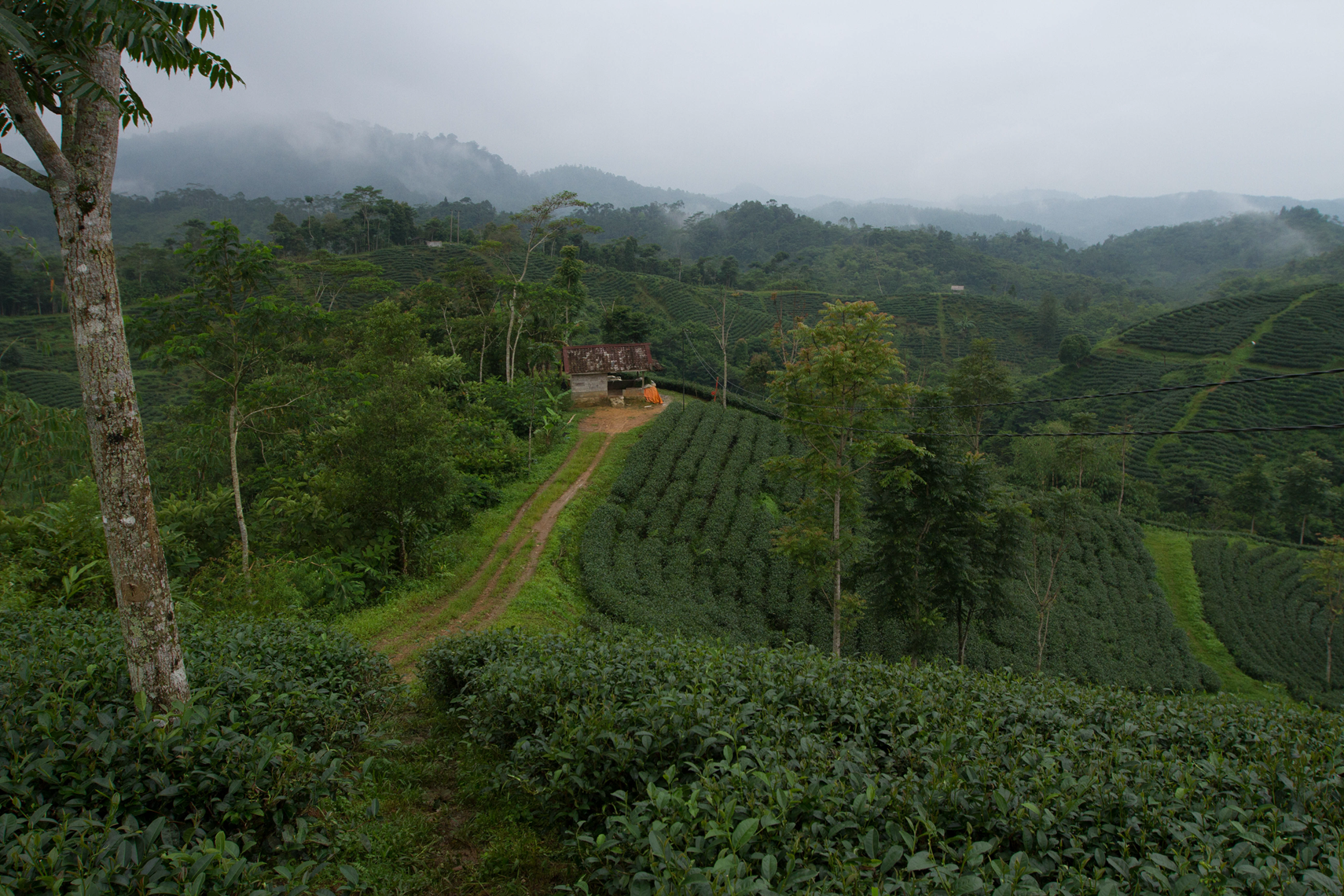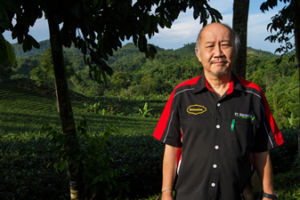
Of the thousands of islands in Indonesia, just two make up the heartland for tea production: Sumatra, the largest of the islands, and Java, the social, political, and economic heart of Indonesia. Both islands enjoy some of the highest average rainfall in the country, and feature a series of steep mountain ranges carved out by tectonic and volcanic activity. Java, in particular, is formed almost exclusively by volcanic eruptions. Together, the two regions make up 99 percent of all tea production in Indonesia with a few small farms in East Kalimantan and South Sulawesi, provinces located towards the center of the archipelago.
The country has just two seasons, wet and dry, but tea grows year round, ideal for maximizing yields. Producers harvest tea constantly, around once every 40-60 days. The government has taken advantage of this agricultural opportunity, and state-owned farms make a large bulk of the country’s production. Growers from Taiwan and China have also seized their opportunity in this new tea region, and many of the farms are equipped with advanced Taiwanese and Chinese equipment. These imports of technology and expertise add to the remarkable consistency of Indonesia’s teas, especially when compared to teas from other relatively new and inexperienced regions like Malawi and Nepal.
The Indonesian Tea Board classifies gardens as private, smallholder or government owned. The latter account for 31 percent equal to 95,000 acres (38,205 hectares) under tea. Smallholder farms total 140,000 acres (56,409 ha) approximately 46 percent of tea lands while private estates account for 23 percent, approximately 70,000 acres (27,931 ha). As the harvest nears completion the country is poised to produce about 143,000 metric tons, down from the 148,000 produced in 2014. Production was 129,000 metric tons in 2015, according to the International Tea Committee which reports exports at 29,000 metric tons through July (compared to 40,000 metric tons through July 2015). Indonesia is the 7th largest producer of tea in the world but ranks 9th in value, according to researchers at the Indonesian Research Institute for Estate Crops (IRIEC). Exports totaled 39,000 metric tons in 2014 but were valued at only $79.6 million. Tea production is decreasing from the 150,000 metric ton norm because landowners are diversifying their farms into other lucrative agricultural commodities. However, Indonesian producers are excited about their prospects, as the local market becomes more interested in high-end teas, and Indonesian specialty teas become better known on the world stage.
There is capacity to grow the domestic market. The country imported 9.3 million metric tons of tea in 2014 (mainly from Vietnam and Iran). Tea consumption per person averages 320 grams per year, a figure far lower than Malaysia’s consumption, which stands at 800 grams, or China and Thailand, which consume 820 and 930 grams, respectively.
The major noteworthy factor for Indonesia’s 2016 harvest is a longer-than-usual rainy season, which may be attributable to global warming. For some farmers, this means increased yields; for others, it means a problematic harvest. This particularly rainy harvest will affect each farm differently, based on location, cultivation techniques, and tea processing styles.
For BukitSari, the largest certified organic producer in Indonesia, the weather threatens to cause decreased yields this year. BukitSari is one of the most well-established farms in the country, and was founded in 1920. Around for almost a century now, it offers an inspiring and sustainable model for Indonesian producers. The farms are located in Cianjur, Java, at 1,150-1,350 meters above sea level, and they specialize in quality white, green, and black teas. They primarily grow C. assamica, the broad leaf variety, which is right at home in the tropical environment. This results in bold, full-bodied teas. Currently, they are also experimenting with the C. sinensis variety.
BukitSari’s tea plants are sheltered in a valley, which provides protection against typhoons. However, the uneven, sloping terrain still becomes an obstacle course during the heavy rains. This prevents the tea pluckers from harvesting any tea. “It is difficult to do appropriate plucking now,” says Ronald Goenawan, product manager for BukitSari. “It is supposed to be the hot season now, but so far it has been still raining hard from 10AM till late afternoon.” The farm already receives an incredible amount of rain on average, around 2,500-3,400mm per year. What Goenawan and his team need is more sunlight in the coming weeks for a successful harvest.
Appropriate plucking is especially important for specialty producers like BukitSari. Quality teas demand a high plucking standard, and meticulous processing. Once the tea bushes flush, the tea pickers must harvest the leaves while they are still young and tender. In just a matter of days, the leaves can become overgrown. Tea made from these older, tougher leaves is harder to process, and yields a much less flavorful tea. Rainy days can also disrupt processing due to increased humidity, which can lead to sour notes in the final product.
Not too far from BukitSari, another specialty tea producer closely monitoring his plants, waiting for the perfect time to pluck. Five hours west of Cianjur, in Banten Province, Java, Dr. Alexander Halim has established PT Harendong Green Farms. Established in 2005, the farm is Dr. Halim’s project to promote a better quality of life through sustainable farming. BukitSari and PT Harendong are the only two certified organic producers in Indonesia.

It is apparent why Dr. Halim has chosen to protect the environment surrounding his tea farms, given the stunning natural beauty of this landscape. Dr. Halim’s farms are located at 1,000 meters above sea level, and enjoy a mineral-rich andosol soil type. The area receives slightly less rainfall than Cianjur, at 2,700-3,000 mm yearly. Nearby is Gunung Halimun-Salak National Park, an area protected for its biodiversity and pristine environment. Luckily, the farm is also sheltered from typhoons. All of the plants are of the Camellia sinensis sinensis variety, specifically Cui Yu, Jin Xuan, and Qing Xin from Taiwan. These cultivars flourish in the mid-elevation mountain terroir, and can be harvested every 45-50 days.
Dr. Halim is enjoying an uneventful harvest year at PT Harendong, with none of the same issues with heavy rain. He reports that 2016’s growing conditions are much the same as 2015’s; these peaceful conditions are ideal for teamakers, as they can concentrate on improving the farm and their tea crafting. Dr. Halim works to improve his organic practices and finetune the processing of his teas, which are crafted with inspiration from Chinese and Taiwanese teas. One black tea skillfully leverages the earthy characteristic of the Indonesian terroir, offering a sweet, rounded profile similar to a Chinese Qimen black. Another tea, modeled after Taiwanese baozhong, has the flowery oolong profile with a pristine character. True to their Indonesian origin, PT Harendong’s teas are remarkably consistent from year to year. The team will only benefit from their predictable weather and growing conditions.
Across the straits, in Bengkulu Province, Sumatra, tea grower Christine Chou is also enjoying ideal growing conditions for her plants. The Chou Family, originally from Taipei, is the first grower granted permission by the Taiwanese government to establish Taiwanese-style farms abroad. In 1989, they expanded their farms, Mountain Tea, to Indonesia. The family had noticed that the high elevation, rainy climate, and forested landscape echoed the high mountain tea farms of their homeland.
The farm is located at 3,600 feet (1,100 meters) above sea level, and the region sees about 110 inches (2,800 mm) of rainfall a year. The soil is volcanic black loam, rich with organic materials thanks to Sumatra’s particularly lush rainforests. The family has chosen cultivars from their native Taiwan, specifically Qing Xin, Cui Yu, Jin Xuan, and Tie Guan Yin from the C. sinensis variety, which are harvested every 52 days. With these cultivars, and the somewhat similar growing environment, Mountain Tea can craft teas like traditional high-fire Tie Guan Yin oolong in a place far away from home. Their teas exhibit the mastery and confident techniques from Chinese and Taiwanese tea crafting, along with that reliable Indonesian consistency. The distinct Indonesian flavor notes also shine through in these oolong teas, with a particular mineral crispness and earthy, rocky undertone. Even in their roasted teas, the smoky character feels cleaner, more pristine.
Unlike at BukitSari, where the rain is excessive rather than abundant, Mountain Tea is enjoying the longer-than-usual rainy season. Their tea pluckers have no issues with the terrain of the farm, so they have been able to harvest the quickly-growing leaves at the right time. Temperatures are lower than normal, which is suitable for their particular crop; cooler temperatures tend to decrease the astringency of tea, ideal for Taiwanese-style oolong processing. The family also maintains a modern Taiwanese-style processing plant, with a controlled environment that allows them to monitor humidity, temperature, and other critical factors. This means that they can more easily process teas regardless of rain or shine, whereas smaller farms may not be able to sun-dry their white teas, or properly roast their oolong teas, in a workshop more exposed to the elements.
When it comes to the tea harvest, even small factors can make a big difference, even in the particularly consistent conditions of Indonesia. It is a testament to the incredible sensitivity and complexity of the tea making process, and to what the tea maker must constantly consider for his crop.
For the tea drinker, Indonesia is a region to watch: it provides a fascinating bridge between China and Taiwan, and the rest of the less experienced, but more inventive tea producing world. Indonesia unites traditional tea and modern approaches, like sustainable farming and optimized production, and presents a little-explored selection of teas that are colored by the unique terroir of its beautiful, rain-soaked, and volcanic landscape.
I have only ever drunk Javanese tea (e.g. Teh Tjatoet/Teh Pabrik Kwee Pek Hoey–very common brand in Yogyakarta). Could you tell me something about that kind of tea?
Where do people drink/buy the kind of tea you describe in Java?